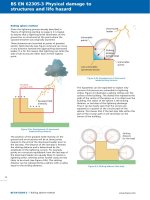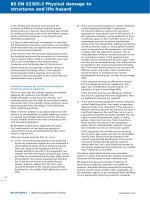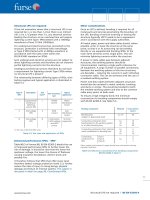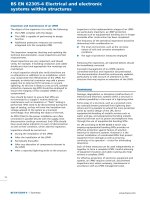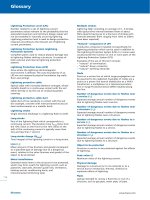Bs en 124 update uk en
Bạn đang xem bản rút gọn của tài liệu. Xem và tải ngay bản đầy đủ của tài liệu tại đây (80.59 KB, 3 trang )
BS EN 124:2015
Gully tops and manhole tops for vehicular
and pedestrian areas
Revised edition March 2017
BS EN 124:2015, the Standard for gully tops and manhole tops for vehicular and
pedestrian areas was published on 31 July 2015. It is a substantial revision to the 1994
version, as it splits the standard into one general part and five material specific parts,
and it brings products made of different materials into the scope of BS EN 124.
Which are the relevant standards in the BS EN
124:2015 series?
BS EN 124-1:2015
Definitions, classification, general
principles of design, performance
requirements and test methods
BS EN 124-2:2015 Gully tops and manhole tops made
of cast iron
BS EN 124-3:2015 Gully tops and manhole tops made
of steel or aluminium alloys
BS EN 124-4:2015 Gully tops and manhole tops made
of steel reinforced concrete
BS EN 124-5:2015 Gully tops and manhole tops made of
composite materials
BS EN 124-6:2015 Gully tops and manhole tops made of
polypropylene (PP), polyethylene (PE)
or unplasticized poly(vinyl chloride)
(PVC-U).
You can find these standards on our BSI shop
/>
BS EN 124:2015 and CE marking
Whilst the standard has expanded to reflect different
materials, one of the most significant changes is that it
also contains an Annex ZA for all these standards thereby
detailing a route to CE marking.
CE marking declares that your product complies with all
applicable European Directives and Regulations allowing
you to legally market and distribute your product within the
European Economic Area.
CE marking is affixed by the manufacturer in line with the
requirements of the Construction Products Regulation and
the Annex ZA of the appropriate standard, EN 124:2015
in this case. The product must fall within the scope of
the standard and depending upon the required system of
Assessment and Verification of Constancy of Performance
(AVCP) the tasks are shared between the manufacturer and
the Notified Body.
If a more detailed explanation of CE marking in accordance
with the Construction Products Regulation is needed, please
view our webage bsigroup.com/cpr
Whilst the revised standards detail a route to
CE marking, it is not currently possible to affix
CE marking to gully and manhole tops.
Read more overleaf >>
BS EN 124:2015 Gully tops and Manhole covers
The European Commission has taken the decision not to cite
the EN 124:2015 suite of standards in the Official Journal of
the European Union (OJEU). Only once this has been done
can CE marking be affixed to a product.
We will continue to provide updates on the OJEU status of
BS EN 124:2015 as further information becomes available.
BS EN 124:2015 and BSI Kitemark™
The CEN technical committee TC165 in May 2016 stated:
“In the short term it is recommended that specifiers and
users continue to adopt and comply with EN 124:1994,
making use of the existing third party certification schemes
that are in place. National Notified Bodies are developing
certification schemes that accord with EN 124:2015 (parts
2-6, if applicable) and specifiers and users are encouraged to
transition to the new schemes on a voluntary basis as they
become available.”
We offer BSI Kitemark certification against BS EN 1242: 2015. Whilst we see the importance of providing
certification against the latest version of the standard, we
have taken the decision to continue offering BSI Kitemark
certification against BS EN 124: 1994 for the foreseeable
future. This is in line with the recommendations from the
CEN technical committee and will continue to support the
marketplace.
For the UK market, any gully or manhole tops installed
must comply with the specified requirements of Highways
England.
Coping with compliance
We’ve compiled some useful questions below which explains what
the new standard means for clients who have a BSI Kitemark.
Q:I have a BSI Kitemark to BS EN 124:1994 is it
still valid?
A: Yes, your BS EN 124:1994 certificate is still valid. You
are not able to affix CE marking, and you do not have
to transfer your certification to the 2015 standard
straightway.
Q:I have a BSI Kitemark to BS EN 124:1994 for
Cast Iron products and I want to transfer
my certification to BS EN 124-2:2015.
What do I need to do?
A: We offer BSI Kitemark certification against both the
BS EN 124:1994 and BS EN 124-2:2015 versions of the
standard. Transferring your certification to the
BS EN 124-2:2015 version is optional and we will not
be withdrawing any BSI Kitemark certificates to
BS EN 124:1994 at this present moment. We anticipate
that the BS EN 124:1994 version will remain relevant
as a standard for BSI Kitemark for some time to
come. If you wish to certify part or all of your product
range under BS EN 124-2:2015, please contact us.
Gully and
Manhole Tops
Q:I have a BSI Kitemark to BS EN 124:1994 or a
BSI Kitemark to BS EN 124-2:2015 and all my
production is sold into Europe – what do I do?
A: Affixing CE marking is not possible and products can
continue to be sold into Europe without CE marking. As
many countries still require evidence of compliance, the
BSI Kitemark is an invaluable tool to support your access
to the marketplace..
Q:What are the main differences between a
BSI Kitemark and CE marking?
A: A BSI Kitemark is a voluntary trademark, unique to
BSI, which not only meets the requirements of CE
marking, but underlines a continual commitment to
producing high quality, durable and fit for purpose
products. In order to achieve a BSI Kitemark, companies
must have their products independently tested to
all the appropriate requirements of the standard
as well as pass an assessment visit from BSI.
Read more overleaf >>
bsigroup.com
Clients with a BSI Kitemark certificate will enjoy an
advantage when applying for CE marking, as the
BS EN 124 requirements for CE marking and BSI
Kitemark are very similar. However, some of the
performance criteria for BSI Kitemark are more stringent,
and therefore enable clients to use it as a significant
differentiator when competing in the market or
securing new opportunities. CE marking is mandatory
and must be applied to all products manufactured to a
harmonised European standard and that are sold within
the EEA. To affix CE marking companies must be able
to demonstrate compliance with the Annex ZA in the
harmonised standard. CE marking to BS EN 124:2015 is
to AVCP system 1 – for which no on-going product audit
testing takes place, this is not the case with BSI Kitemark
where samples are taken every year for independent
testing to demonstrate on-going compliance.
Q:Will I have to fully type test my entire range
of products in order to gain BSI Kitemark
certification against BS EN 124-2:2015?
A: BS EN 124:1994 and BS EN 124-2:2015 have many
similarities and so full testing may not be necessary if
your products remain the same. Our technical team will
be happy to discuss this with you in more detail.
Q:When can I start my transfer to
BS EN 124-2:2015?
A: Now, our team are ready to help.
Q:Could I pilot with BSI for the other material
parts of the standard?
A: Please contact us to find out whether this is possible.
Why BSI?
Our knowledge, expertise and drive can make a difference to your business:
• As a Notified Body for many key European
Regulations and Directives, we have the
experience and technical capability to help our
clients achieve CE marking when this becomes
available.
• We continue to lead the way with ongoing
developments in various industries
• We provide end-to-end support, helping
you monitor and maintain your excellence
throughout.
• You can enjoy the benefits of working with BSI
teams who have decades of experience helping
businesses of all sizes
• We are the pioneers of many of the world’s
first standards
• We are renowned for our innovative work
T: +44 345 0765 606
F: +44 1908 814920
bsigroup.com
© BSI Group
BSI Group
Kitemark Court
Davy Avenue, Knowlhill
Milton Keynes MK5 8PP
Call us on 0345 0765 606 or email us at
or visit bsigroup.com/en124-uk
BSI/UK/678/PC/0915/enBLD
in many fields
If you have any further questions
regarding BS EN 124 and the
CE marking process, one of our
BSI specialists can help you.



